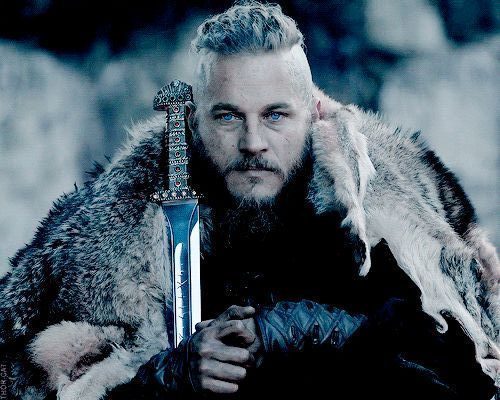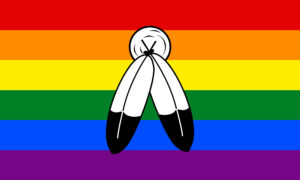For three hundred years, beginning in the ninth century, they sailed the known world and discovered lands beyond their maps.1 They pillaged the peoples of England and France, canals along Middle Eastern coasts, and even their own Scandinavia, venturing as far as the east coast of North America. Being given names, such as pirates, barbarians, monsters, and farmers, today we know them as Vikings. Their people did not fear death in combat, and they would go to great lengths to find a worthy way to die. Being killed heroically with a weapon in hand could get the attention of a Valkyrie, or angelic female warrior, to determine if ones death was worthy. If deemed worthy one would ascend to Valhalla, the Nordic afterlife for a warrior, where one would brag about one’s adventures and fight to the death daily in the army of Oden, chieftain of the Norse gods, as preparation for the end of the world. One man that stood out among these hardened people and became one of the first Scandinavian kings was Ragnar Lothbrok.2
Being born just before the turn of the year 800 CE, Ragnar Lothbrok brought together the Scandinavian war bands under his command. With Europe poorly protected, and with Charlemagne’s rule coming to an end, Ragnar took the advantage and led his Vikings on many campaigns to loot Europe of its treasures.3 With little real knowledge of the Norsemen, the peoplesand treasures of Europe were easy targets. When in the fighting line, Ragnar was said to dwarf his companions that stood around him and fought in his armies as a berserker.4 A berserker is a warrior that fights in a rage-filled trance, being able to take on multiple injuries before falling in battle. Ragnar was admired for his skills in battle and for his strategic mind. His armies could hold their own against Charlemagne’s forces due to his strategic cunning. Ragnar is even father to other well-known Viking warriors, Bijorn Ironside, Hubb, and Ivar the Boneless, a figure of terror in Irish and English storytelling.5

The untimely demise of Ragnar Lothbrok became a story of revenge. With so many battles and victories against the Anglo Saxons, Ragnar had created enemy in Aelle, ruler of York. During Ragnar’s last battle, he was captured by the Anglo Saxons and became a prisoner. In honor of his new prisoner, Aelle, ruler of York, ordered his men to build a pit of snakes for Ragnar to be thrown into. As the snake venom was running through Ragnar’s veins, he is reported to have uttered, as his last words, “How the little pigs will grunt when they hear how the old boar has died,” referring to his sons as the avengers of his death.6 The death of Ragnar Lothbrok supposedly triggered a new age of Viking attacks. Those attacks had the ferocity and intensity that Vikings later became known for. Seeking to avenge their father’s death, Ivar the Boneless and his two brothers led their Viking forces to East Anglia in 865 CE. In the name of revenge, the brothers captured Aelle and killed him with the rite of the blood eagle.7 This rite was a gruesome and painful form of execution by torture that resulted in a slow death; after the torture, the poor soul subjected to the rite was to be tied by the wrists in the air to two separate trees, to resemble a bird in flight, to honor Oden’s sacred bird, the eagle. The ritual was so gruesome that it was hardly ever used and only on those deserving of it.

The story of Ragnar Lothbrok became a legend and was written into the Icelandic sagas and the Gesta Danorum.8 Over time he became another epic hero in a story with impossible adventures. Between the seventh and ninth centuries, multiple stories and lives of other people named Ragnar have surfaced. Despite these multiple stories, there will only be a true original Ragnar Lothbrok, the one that forced his way into history and built the reputation of the Vikings.
- Gale Encyclopedia of World History, 2008, s.v. “Viking Raids and Norman Conquests (8th to 11th Centuries).” ↵
- P.D. Kirby, “Review of A.P. Smyth’s Scandinavian Kings in the British Isles 850-880,” The English Historical Review 94, no. 370 (January 1979): 162-163. ↵
- P.D. Kirby, “Review of A.P. Smyth’s Scandinavian Kings in the British Isles 850-880,” The English Historical Review 94, no. 370 (January 1979): 162-163. ↵
- Gale Encyclopedia of World History, 2008, s.v. “Viking Raids and Norman Conquests (8th to 11th Centuries).” ↵
- Encyclopedia of the Barbarian World, 2004, s.v. “Bronze Age to Early Middle Ages,” by Peter Bogucki and Pam J. Crabtree. ↵
- Encyclopedia of the Barbarian World, 2004, s.v. “Bronze Age to Early Middle Ages,” by Peter Bogucki and Pam J. Crabtree. ↵
- Roberta Frank, “Viking Atrocity and Skaldic Verse: The Rite of the Blood Eagle.” The English Historical Review 99, no. 391 (April 1984):332-343. ↵
- Neil Schlager and Josh Lauer, Science and Its Times (Detroit: Gale, 2001), 100-101. ↵



50 comments
Rebekah Esquivel
The vikings seemed like really strong people. I really liked how the article was put together. Before this article I had never heard of Ragnar Lothbrok before. This article helped to show the importance of family to the vikings. Although it was a weird way of showing it his “sons” revenging his death showed the importance. I enjoyed reading this article and learning about the history of the Viking Ragnar Lothbrok.
Megan Barnett
I found the start of your article to be entertaining because it felt as if I was watching a television series and that was the introduction to the show. The explanations for certain unusual words was done very well along with the plot of the story. In school we do not really cover much of the vikings so this brief account included new information for me.
Prof. Roger Martinez
Your reference to “berserkers” is really intriguing! It made me think about a wonderful primary source, The Anglo-Saxon Chronicle of King Alfred the Great (of England) during the 8th century. Here is an excerpt that discusses wars with Vikings. It is from the Internet Medieval Sourcebook. https://sourcebooks.fordham.edu/source/angsax-chron1.asp
“885. In this year the fore mentioned army separated into two; one part [went] east, the other part to Rochester, and besieged the city, and wrought another fastness about themselves; but they, nevertheless, defended the city until King Alfred came without with his force. Then the army went to their ships, and abandoned the fastness; and they were there deprived of their horses, and forthwith, in the same summer, withdrew over sea. And the same year King Alfred sent a naval force from Kent to East Anglia. As soon as they came to the mouth of the Stour, then met them sixteen ships of vikings, and they fought against them, and captured all the ships, and slew the men. When they were returning homeward with the booty, a great naval force of vikings met them, and then fought against them on the same day, and the Danish gained the victory. In the same year, before midwinter, Carloman, king of the Franks, died, and a wild boar killed him; and one year before his brother died; he also had the western kingdom;and they were both sons of Lewis, who also had the western kingdom, and died in the year when the sun was eclipsed, who was the son of Charles, whose daughter Ethelwulf, king of the West Saxons, had for his queen. And in the same year a larger naval force assembled among the Old Saxons; and there was a great fight twice in that year, and the Saxons had the victory; and there were Frisians with them. In that same year Charles succeeded to the western kingdom, and to all the kingdom on this side of the Mediterranean Sea,and beyond this sea, as his great-grandfather had it, excepting the Lidwiccas[Brittany]. Charles was the son of Lewis, Lewis was brother of Charles, who was father of Judith, whom King Ethelwulf had; and they were sons of Lewis;Lewis was son of the old Charles; Charles was the son of Pepin. And in the same year the good Pope Marinus died, who freed the Angle race’s school, at the prayer of Alfred, king of the West Saxons; and he sent him great gifts, and part of the rood on which Christ suffered. And in the same year the army in East Anglia brake peace with King Alfred.”
Crystalrose Quintero
The opening image for the article was completely captivating. The colors of the image really caught my attention and had me wanting to read to know more. I really appreciated that the article began by describing vikings and not directly saying who they were going to speak about. The supposed quotation that Ragnar said before his death was a strong image that really made the article interesting to read.
Richard Navarro
Many people today do not wield the power and mindset that ancient soldiers did. Many will quit after their first injury or altercation. However, I find it interesting how this viking pushed through his injuries and still fought. A man of power like Ragnar Lothbrok definitely has the power to bring small bands together in order to fight against the enemy. Maybe we need men like this in modern day.
Alexis Renteria
I really enjoyed how this article describes the fearless Ragnar Lothbrok, and his ability to fight despite how wounded he was. When i think about Vikings i think about big and strong warriors who show no fear and are ruthless and this article verifies my vision of Vikings. I find it amazing how much of an influence Lothrok had on the history of Vikings and how he shaped our image of what a Viking is made of.
Cameron Ramirez
The Vikings have always fascinated me I think it is impressive how they were able to travel to many places and were the first to step into the New World. I have been meaning to watch the show “Vikings, ” but I have never gotten around to do it. After reading your article, it is now clear that I must see Vikings. I didn’t know much about Ragnar Lothbrok, but with your guidance, I now know more about this man turned legend. Great work Mark keep up the good work!
Michelle Falcon
This article shed light on the history of Vikings, specifically Ragnar Lothbrok and the effect he had on viking history. It tells how Ranger had to make hard decisions that not only effected him but all of his vikings as well. His story is one of revenge and ended with a horrific death. This is a story I have never heard of before and was interested to see how much of an impact Ragnar had on viking history from that point on. Over all it was a very good article.
Alexandria Martinez
This was a very interesting story, stories of the Vikings always are. Before reading this I had never heard of Ragnar, even though his tale is very interesting. The name, however, makes me thing of Ragnarok from the marvel comic and I wonder if his name was used as inspiration. The article was good, and you described what he went through with his death very well.
Carlos Aparicio
This article really intrigued me because I have always wanted to learn more about Vikings and their life stories. Ragnar Lothbrok surprised when he brought together the Scandinavian war bands under his command. He eventually dies but what is amazing is that his sons avenge him, which I thought was very heroic on their part. This article was very interesting to learn about Ragnar Lothbrok and his life.